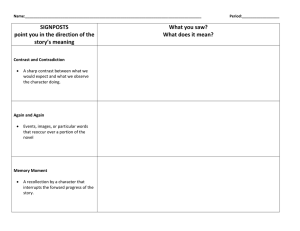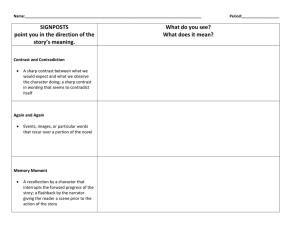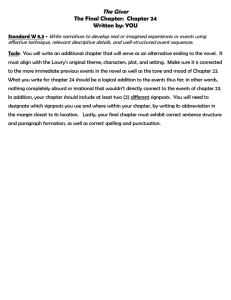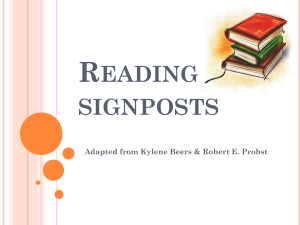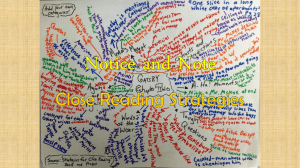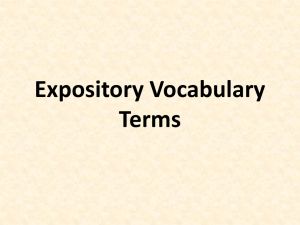Vocab 29: 10 things to know. Quiz Friday
advertisement
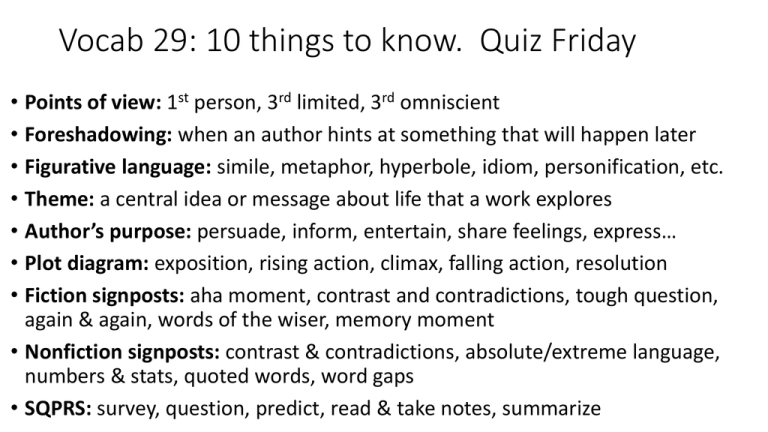
Vocab 29: 10 things to know. Quiz Friday • Points of view: 1st person, 3rd limited, 3rd omniscient • Foreshadowing: when an author hints at something that will happen later • Figurative language: simile, metaphor, hyperbole, idiom, personification, etc. • Theme: a central idea or message about life that a work explores • Author’s purpose: persuade, inform, entertain, share feelings, express… • Plot diagram: exposition, rising action, climax, falling action, resolution • Fiction signposts: aha moment, contrast and contradictions, tough question, again & again, words of the wiser, memory moment • Nonfiction signposts: contrast & contradictions, absolute/extreme language, numbers & stats, quoted words, word gaps • SQPRS: survey, question, predict, read & take notes, summarize • 1st person point of view: the narrator (storyteller) is in the story, usually as the main character. • Sounds like: When I stepped out into the bright sunlight from the darkness of the movie house, I had only two things on my mind: Paul Newman and a ride home. 1st person: It’s as if you are looking through the eyes of the main character. 3rd person Point of view: the narrator is not a character in the story. • 3rd person limited: the narrator follows one character, telling us only their thoughts and feelings. • Sounds like: A Monster Calls • 3rd person omniscient: the narrator follows more than one character, telling us their thoughts and feelings. • Sounds like: Amigo Brothers Foreshadowing: when an author hints about something that will happen later. • For example, when Ponyboy first walked into the old church he said that if it ever caught on fire, there would be no stopping it. This happened way before the church actually caught fire. Figurative language: when you don’t literally mean what you say. You may be using a figure of speech, a simile, metaphor, etc. • Metaphor: compares two unlike things directly • Simile: compares two unlike things using like or as • Hyperbole: a huge exaggeration • Personification: when an author gives human characteristics to nonhuman things • Idiom: a well-known expression Theme: a central idea or message about life that a book explores • How do we identify themes? In lots of ways…. • Did the character learn a lesson? • Can we learn from anyone’s failures? • Were there any big signposts? Aha moments? Again & again? • We could simply ask “Why do you think the author wrote the story?” Author’s purpose •Persuade •Inform •Entertain (also) • Describe • Express • Share feelings Plot diagram: know the five parts • Things to keep in mind: • Exposition gives us characters, setting, and conflict • Rising action usually takes the longest • Climax = turning point of main character Fiction signposts: make sure you know each of these. Aha! Words of the Wiser Again & Again Tough Question Memory Moment Nonfiction signposts • Contrasts and contradictions: same as fiction • Absolute language: when an author makes an extreme statement that may seem a little “over the top.” • Numbers and stats: ask, “Why did the author use these numbers? • Quoted words: When an author chooses to quote someone else, ask “Why was this person quoted? Is he/she an expert?” • Word Gaps: When an author uses a word you don’t know, stop and ask, “Does this look like a word that’s only used with this topic? Do I see any clues to help me understand?” SQPRS: our test-taking strategy •Survey the text •Question •Prediction •Read (& annotate) •Summarize Types of conflict • Man vs. self: an internal conflict. Part of the character wants to ___________, but part of the character wants to ________________ . • Man vs. man: good guy, bad guy • Man vs. society: the world treats the protagonist (hero) unfairly • Man vs. nature: the character must survive against some force of nature
